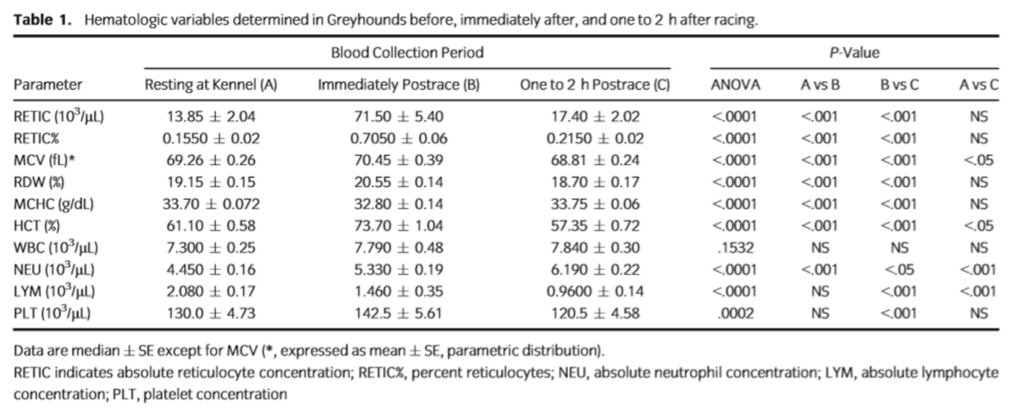Postscript
Let’s look at the study:

Goals
To evaluate the effects of exercise on the concentration of reticulocytes in circulating blood in racing Greyhounds. The authors hypothesized that reticulocyte numbers would be significantly increased immediately after a race, with return to baseline within one to 2 h postrace,
Methods
Blood was collected from 50 racing Greyhounds from a racetrack via jugular venipuncture one day prior to racing (resting), immediately after racing, and 2 h after the race (recovery). Counts were determined using an automated counter.
Findings
Immediately after racing, there was an increased Hct, reticulocyte count, MCV and RDW; and decreased MCHC. These parameters returned to baseline one to 2 h postrace

Comment
The increase in Hct during the race is particularly striking – certainly the envy of our own elite athletes! The most likely scenario is that the exercising greyhound contracts his spleen, resulting in the release of young relatively large retics into the blood.
Learn more here.
Now let’s consider the broader role of splenic contraction as a means of autotransfusion:
- The spleen serves as a reservoir for red blood cells in many mammalian species.
- Splenic contraction leads to “infusion” (autotransfusion) of stored blood cells into the circulation, resulting in increased aerobic performance.
- The splenic capsule contains dense fibrous tissue, elastic fibers, and smooth muscle cells. The amount of smooth muscle in the capsule (high in dogs) may correlate with capacity to contract.
- Contraction of the splenic capsule is mediated by the sympathetic nervous system resulting in contraction of smooth muscle within the splenic capsule.
- Contraction of the splenic capsule is induced by food ingestion, exercise, arousal, hypoxia, bleeding, decrease in blood pressure, diving, and injection of catecholamines.
- In contrast to the greyhound, which can sequester 50% of total RBCs while at rest, the human spleen contains only a small percentage of red blood cells (200-250 ml of blood).
- The true contractile capacity of the human spleen is disputed. The capsule contains little in the way of smooth muscle cells.
- However, immunohistochemical staining has identified contractile proteins not only within the capsule, but also within the reticular cells of the white pulp and sinus lining cells of the red pulp of the spleen.
- This histological evidence indicates that the human spleen could be capable of contracting and regulating its volume from within.
Learn more here.
